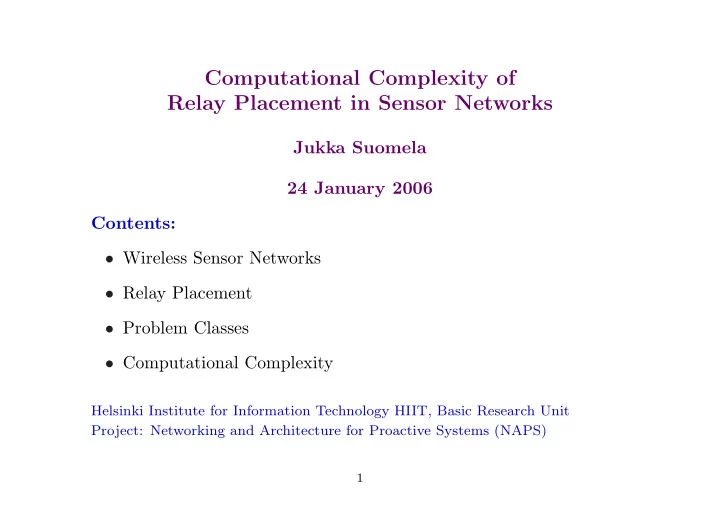

Computational Complexity of Relay Placement in Sensor Networks Jukka Suomela 24 January 2006 Contents: • Wireless Sensor Networks • Relay Placement • Problem Classes • Computational Complexity Helsinki Institute for Information Technology HIIT, Basic Research Unit Project: Networking and Architecture for Proactive Systems (NAPS) 1
Wireless Sensor Networks • Sensor nodes are small and inexpensive computers which are equipped with sensors and wireless communication capabilities • Sensor nodes may be deployed manually or even dropped from an aeroplane • After deployment, sensor nodes form an ad-hoc network which will route data from sensor nodes towards a sink node • Energy consumption must be very low: nodes may need to operate for years without anyone changing or recharging batteries • Possible uses include environmental and weather monitoring; home automation; agriculture; tracking goods in commerce and industry; monitoring machines; health care and medical diagnostics; security systems; and military applications 2
Optimising Sensor Networks (1) Possible target functions: • Lifetime before batteries are drained • Amount of data gathered during lifetime • Quality of data gathered: – coverage: space, time – accuracy of data – probability of detecting or missing events We focus on balanced data gathering : λ min q η + (1 − λ ) avg q η . • Not only lot of data but also some data from all nodes • Formulated by Falck et al. (2004) 3
Optimising Sensor Networks (2) Possible variables: • Node hardware and software • Node placement • Scheduling node activity • Routing • Aggregating, summarising, and buffering data We combine both node placement and routing issues. 4
Relay Placement Problem (1) Problem: • Given a deployed sensor network , • add a small number of new relay nodes • in order to maximise balanced data gathering Typically, the relay nodes would be more expensive devices with larger batteries. Relays do not sense, they only forward data. If we can afford a few relay nodes, where should we put them? 5
Relay Placement Problem (2) Example: ⇒ problem λ = 0 . 0 λ = 0 . 5 λ = 1 . 0 instance maximise maximise average minimum (1.25-approximate solutions illustrated) 6
Problem Classes (1) The general relay placement problem needs to be restricted; otherwise we do not even have a finite parametrisation of a problem instance. We consider restrictions in the following five dimensions. Decision 1. Type: Relay-constrained optimal Relay-constrained k -optimal Utility-constrained optimal Utility-constrained k -optimal 2. Utility: Balanced data gathering 7
Problem Classes (2) Unrestricted 3. Possible relay locations: – Planar – Finite set – Sensor upgrade Unrestricted 4. Transmission costs: – Location dependent – Line-of-sight – Free space 5. Batteries: Unrestricted – Identical 8
All Classes Are NP-hard (1) Reduction from Partition : σ 2 x η ′ x ≤ 2 y 2 y κ ′ 1 µ ′ 1 4 ν 1 1 3 µ 1 z x κ 1 2 1 2 y η 9
All Classes Are NP-hard (2) Battery capacities of nodes κ i σ correspond to values a i in the η ′ κ ′ 4 Partition problem. κ ′ 3 All available data in η ( η ′ ) can κ 4 κ ′ be transmitted to the sink via 2 κ 3 some of the nodes κ i ( κ ′ i ) and κ ′ 1 κ 2 the corresponding relays iff the κ 1 η relays are placed according to the solution of the partition Here X = { 1 , 2 , 3 } is a problem. solution to the Partition A solution is optimal iff all problem: a 1 + a 2 + a 3 = a 4 . available data is gathered. 10
With Obstacles, Approximation Is NP-hard (1) Reduction from Set Covering : ( a + n − 1) y/ 2 Holes, Ξ ij Tunnels, T i (a) y/ 2 Nests, Λ i (b) 4 4 (c) η 1 x Ψ j Slot Υ j 2 x κ 1 j κ 2 j η 2 y x Ψ ′ j η 3 Slots, Υ i ( a + 2 n − 1) y η 4 x (d) η 5 y/ 4 y/ 4 (e) x x x σ y µ 1 µ 2 11
With Obstacles, Approximation Is NP-hard (2) Reduction from Set Covering : • Placing m relays corresponds to choosing m subsets. • For each i , there is a transmission path η i → relay → sink iff there is a subset that contains i . • Choose λ = 1, optimise minimum. The utility is zero unless some data is gathered from each node. • Finding a solution with any positive utility is at least as hard as solving Set Covering exactly. • Any approximation algorithm for relay placement would provide an exact solution to Set Covering . 12
Papers • J. Suomela: Computational complexity of relay placement in sensor networks. Proc. SOFSEM 2006 . • P. Flor´ een, P. Kaski, J. Kohonen and P. Orponen: Exact and approximate balanced data gathering in energy-constrained sensor networks. Theoretical Computer Science 344 (2005). • E. Falck, P. Flor´ een, P. Kaski, J. Kohonen and P. Orponen: Balanced data gathering in energy-constrained sensor networks. Proc. Algosensors 2004 . Software • Source code for k -optimal relay placement is freely available. 13
Summary • How to optimise data gathering in wireless sensor networks by adding a small number of new relay nodes Future Research • More on approximability and inapproximability • Focus on the amount of new relevant information instead of the amount of raw sensor readings • Not only relay placement and routing but also sensor placement and data aggregation Jukka Suomela, jukka.suomela@cs.helsinki.fi , http://www.cs.helsinki.fi/jukka.suomela/ 14
Recommend
More recommend